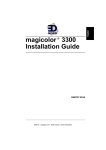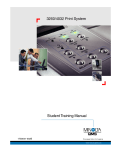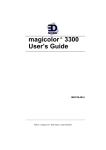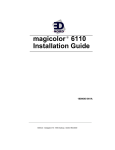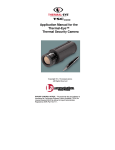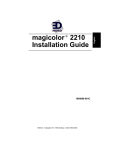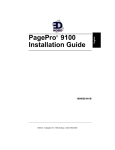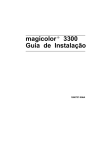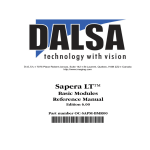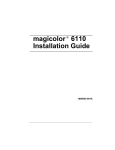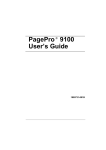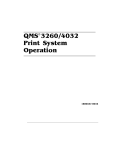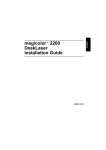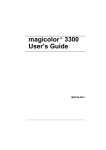Download Minolta MAGICOLOR 3300 Installation guide
Transcript
English ® magicolor 3300 Installation Guide 1800737-001A English Thank You Thank you for purchasing a magicolor 3300. You have made an excellent choice. Your magicolor 3300 is specially designed for optimal performance in Windows, Macintosh, UNIX and other environments. Trademarks KONICA MINOLTA and the KONICA MINOLTA logo are trademarks or registered trademarks of KONICA MINOLTA HOLDINGS, INC. magicolor is a trademark or registered trademark of KONICA MINOLTA PRINTING SOLUTIONS U.S.A., INC. Proprietary Statement The digitally encoded software included with your printer is Copyright © 2003 KONICA MINOLTA BUSINESS TECHNOLOGIES, INC. All Rights Reserved. This software may not be reproduced, modified, displayed, transferred, or copied in any form or in any manner or on any media, in whole or in part, without the express written permission of KONICA MINOLTA BUSINESS TECHNOLOGIES, INC. Copyright Notice Copyright © 2003 KONICA MINOLTA BUSINESS TECHNOLOGIES, INC., Marunouchi Center Building, 1-6-1 Marunouchi, Chiyoda-ku, Tokyo, 100-0005, Japan. All Rights Reserved. This document may not be copied, in whole or part, nor transferred to any other media or language, without written permission of KONICA MINOLTA BUSINESS TECHNOLOGIES, INC. Manual Notice KONICA MINOLTA BUSINESS TECHNOLOGIES, INC. reserves the right to make changes to this manual and to the equipment described herein without notice. Considerable effort has been made to ensure that this manual is free of inaccuracies and omissions. However, KONICA MINOLTA BUSINESS TECHNOLOGIES, INC. makes no warranty of any kind including, but not limited to, any implied warranties of merchantability and fitness for a particular purpose with regard to this manual. KONICA MINOLTA BUSINESS TECHNOLOGIES, INC. assumes no responsibility for, or liability for, errors contained in this manual or for incidental, special, or consequential damages arising out of the furnishing of this manual, or the use of this manual in operating the equipment, or in connection with the performance of the equipment when so operated. Registering the Printer Mail (Americas only)—Fill out and send in the registration card enclosed in your shipment. Internet—Go to printer.konicaminolta.net/register and follow the instructions given there. CD-ROM—Follow the instructions on the Software Utilities CD-ROM. English Contents Getting Acquainted with Your Printer ...........................................1 Printer Features 1 Documentation Set 2 Space Requirements 2 Location Requirements 3 Printer Parts 4 Setting up Your Printer ...................................................................6 Shipment Contents 6 Unpacking the Printer 6 Installing the Imaging Unit 7 Preparing the Toner Cartridges 10 Loading the Upper Media Tray 11 Loading the Multipurpose Tray 13 Installing Accessories ..................................................................14 Plugging in/Turning on the Printer ..............................................15 About the Interface Panel .............................................................16 What’s Next? .................................................................................17 English Configuration Menu Overview .................................................... 18 Menu Chart Conventions 18 About the Control Panel .............................................................. 19 Selecting a Message Window Language 19 Control Panel Indicators 20 Control Panel Keys 21 Menu, Select, Previous, and Next Keys 22 Manually Selecting an Ethernet IP Address 22 Troubleshooting ........................................................................... 24 Additional Assistance 25 Color Registration 26 Accessories and Consumables .................................................. 29 Accessories 29 Consumables 30 Warranty Considerations ............................................................ 30 Safety Information ........................................................................ 32 Regulatory Compliance 32 FCC Compliance Statement 32 Canadian Users Notice 33 CE Marking (Declation of Conformity) 33 Laser Safety 34 International Notices 34 ii English Getting Acquainted with Your Printer Printer Features Feature Details Print speed (color and monochrome black) Media Print quality size (dots per inch/dpi) Letter Print speed (pages per minute/ppm) Standard—600x600 Up to 26 Quality—1200x1200 full speed Fine—1200x1200 Up to 13 half speed A4 SDRAM Standard—600x600 Up to 24 Quality—1200x1200 full speed Fine—1200x1200 Up to 12 half speed 256 MB (expandable to 512 MB) 500-sheet upper media tray 100-sheet multipurpose media tray Standard Standard 500-sheet (1x500) highcapacity input feeder (HCIF)* Optional 1,000-sheet (2x500) highcapacity input feeder (HCIF)* Optional IEEE-1284 parallel Ethernet Standard Standard USB 1.1 Internal IDE Hard Disk Standard Optional Time-of-Day Clock Autoduplex Printing Optional magicolor 3300 DN—Standard magicolor 3300 EN—Optional * Only one high-capacity input feeder may be installed at a time. Getting Acquainted with Your Printer 1 English Documentation Set If you’re using the Acrobat PDF version of this guide, click this icon to play a QuickTime video clip of the procedure described in the text. Acrobat Reader and a download link to QuickTime are provided on the Documentation CD-ROM. Manual Description Quick Setup Use this sheet when unpacking the Guide printer. Installation Guide Location* Hardcopy and Documentation CD-ROM You’re looking at this document right now. Hardcopy and This guide provides information about Documentation printer installation, the interface panel, CD-ROM and the control panel. User’s Guide This manual guides you through the Documentation day-to-day operation of your printer, CD-ROM including information on printing files, refilling print media, and replacing toner. It also includes information on additional accessories, cleaning and maintaining the printer, improving print quality, troubleshooting printer problems, technical specifications, and safety. Crown Books These manuals provide detailed 1 and 2 information about Crown architecture, color printing, menu configuration, and advanced computer/network connection and configuration. Service & Support Guide Documentation CD-ROM Documentation This guide lists sources of service and support for many areas of the world. The CD-ROM most current information can be found at www.konicaminolta.net/printer/. * All manuals can also be found on the Internet at printer.konicaminolta.net/support. Space Requirements The following illustrations show the amount of space required around the printer for adequate ventilation and for operating the printer, replacing consumables, and removing media jams. 2 Getting Acquainted with Your Printer A B English Top View A 4"/100 mm B 24"/600 mm C C 8"/200 mm D 6"/150 mm E 4"/100 mm F 6"/150 mm D G 24"/600 mm H 8"/200 mm Front View E Side View F G H Location Requirements Locate your printer in a space with these characteristics... On a hard, flat, stable, level (±5° or less slant at any point on the machine) surface. A surface can be tested for levelness with a standard round pencil. If the pencil rolls, the surface is not level. Close to an easily accessible grounded power supply (on an exclusively dedicated power outlet) that meets printer specifications. Near your computer—at the length 6.5'/2 m or less for an IEEE 1284 bidirectional parallel connection. With enough space to allow adequate ventilation and easy servicing. With an ambient temperature range of 50°–90° F/10°–32° C and relative humidity range of 15%–85% (noncondensating). At an altitude of 0–10,170'/0–3,100 m. But away from... Direct sunlight, heating and cooling sources, extreme temperature and humidity changes, wind, dust, open flames, and items that can easily burn. A connection to the same electrical circuit as high-current machines, noise-generating equipment (such as a copier or air conditioner), and strong magnetic or electromagnetic fields (such as a refrigerator). Water, water pipes, liquid (drink) containers, and corrosive chemicals or vapors, such as ammonia. Small, loose metal parts, such as paper clips and staples. Getting Acquainted with Your Printer 3 English WARNING! Obstructing the ventilation grilles could present a fire hazard. Do not tilt the printer more than 10° when moving it. Attention Do not connect the groundwire to gas or water pipes or grounding for telephones. For further details, refer to the User’s Guide on the Documentation CD-ROM. Printer Parts The following drawings illustrate the parts of your printer referred to throughout this guide, so please take some time to become familiar with them. Front View 1—Top cover/face-down output tray 2—Control panel and message window 3—Front cover 4—Cover Button B 5—Multipurpose tray (shown closed) 6—Cover Button A 7—Ventilation grilles 8—Power switch 9—Upper media tray 10—Media level guide 11—Carrying grips (both sides) 4 11 Getting Acquainted with Your Printer Rear View English 1—Top cover 2—Toner cartridges 3—Ventilation grilles 4—AC power connection 5—Interface panel 6—Media tray cover Top Internal View Button A 1—Transfer unit 2—Registration rollers 3—Imaging unit 4—Imaging unit cover Getting Acquainted with Your Printer Button B 5—Duplexer rotator 6—Fuser unit 7—Imaging unit cover 5 English Setting up Your Printer WARNING! Your printer weighs approximately 65 lbs (29.5 kg) without consumables and accessories. Be sure to have help when lifting and moving it. Shipment Contents Printer (with 100-sheet multipurpose tray and 500-sheet upper media tray) Consumables a a Imaging unit b Four toner cartridges (already installed) Power cord Software Utilities and Documentation CD-ROMs b Quick Setup Guide Installation Guide Registration card (Americas only) Interface cables aren’t included in the shipment. If you need cables, contact your local vendor or computer store. Unpacking the Printer We strongly suggest that you save the packaging materials in case you ever need to move or ship the printer. After removing the consumables from the printer carton, use the following instructions to unpack your printer. 1 Remove the protective plastic cover. WARNING! Lift the printer only from the front and back. Lifting it from the sides may cause it to tip over. 6 Setting up Your Printer With another person’s help, lift the printer from the carton. Front English 2 Do not tilt it more than 10° in any direction at any time. 3 For best output quality and longest consumables life, place the printer on a hard, flat, level, stable surface capable of supporting about 77 lbs (35 kg). Hand grips Remove the tape from the outside of the printer. Attention Do not plug in the power cord until told to do so. Installing the Imaging Unit The imaging unit contains four OPCs (Optical Photo Conductors) and developers, and an imaging unit transfer roller that form the image that is developed and transferred to the media. Attention The OPCs are extremely sensitive to bright light, direct sunlight, and touch. Always leave the imaging unit in its protective bag until you’re ready to install it. Any exposure to light should be limited to less than two minutes, or permanent damage could result. Setting up Your Printer 7 Open the printer’s front cover (button A), and remove any tape. English 1 2 1 2 3 4 A Open the imaging unit cover. Remove the imaging unit from its protective bag. Holding the imaging unit horizontally, carefully pull the tabs straight out and completely away from the unit. Attention Do not twist the tab as you are pulling it. If any tab doesn’t pull completely out (you must be able to see the circle imprinted on the end), the imaging unit must be replaced. 660 mm 26"/ 5 8 Carefully remove the protective cover. Setting up Your Printer Gently guide the imaging unit straight into the printer, following the arrows on the printer to seat all four pins. English 6 Attention You can damage the imaging unit if it is not aligned correctly. 7 Remove the protective black sheet. Dispose of it according to your local regulations. Do not dispose of it by burning. Attention Do not touch the black transfer roller or allow anything to come in contact with the OPC. It is extremely sensitive to hand oils and scratches, both of which reduce print quality. This type of damage is not covered by your warranty. 8 9 Close the imaging unit cover . Close the front cover . Setting up Your Printer 9 English Preparing the Toner Cartridges Your printer uses four toner cartridges: black, yellow, magenta, and cyan. They are already installed in the printer, but you must prepare them for use. For a list of toner life expectancies and toner replacement instructions, refer to chapter 1, “Replacing Consumables,” in the User’s Guide (on the Documentation CD-ROM). The toner is nontoxic. If you get toner on your hands, wash them in cool water and mild neutral detergent. If you get toner on your clothes, lightly dust them off as much as possible. If some toner remains on your clothes, use cool, not hot water, to rinse the toner off, provided your clothing is washable. WARNING! If you get toner in your eyes, wash it out immediately with cool water and consult a doctor. Material Safety Data Sheets (MSDS) information can be found at printer.konicaminolta.net/support (click on Answer Base). 1 2 Remove the printer’s top cover. Pull the toner seal of the black toner cartridge straight up. Attention Pulling the seal to the front or side may damage the cartridge. 3 4 10 K C M Y If the toner seal didn’t pull completely out because it was pulled with too much force or it was not pulled straight up, call Technical Support. Refer to the Service & Support Guide (on the Documentation CD-ROM) or www.konicaminolta.net/printer/ to find the office nearest you. Repeat step 2 to remove the toner seals from the other three toner cartridges. Replace the top cover. Setting up Your Printer English Loading the Upper Media Tray The upper media tray holds 500 sheets of 20 lb bond (75 g/m²) paper. For information about loading and using other types of media, refer to chapter 2, “Using Media,” in the User’s Guide on the Documentation CD-ROM. 1 Slide out the media tray and remove the shipping spacers. 2 3 4 The illustration shows an upper media tray; however, instructions are the same for the high-capacity input feeder (HCIF) trays. Using both hands, lift the media tray slightly to remove it from the printer, and place it on a flat surface. Adjust the two side media guides. Gently lift the end media guide and position it in the proper media size hole. The illustration of the tray shown here is in reverse of the illustration in step 3. Attention If the guide is not in the proper hole, automatic paper size detection will not work. Setting up Your Printer 11 English 5 Fan a stack of approximately 500 sheets of letter/A4 paper. A fill limit mark is provided on the inside right side of the tray. Attention Do not overfill the tray. The paper should fit easily between the guides. Improperly adjusted guides may cause poor print quality, media jams, or printer damage. 6 Align the four edges of the media, and then load it with the printing side up. Often, an arrow on the media package label indicates the printing side of the media. 7 8 Make sure the paper corners are not bent and that they are under the media-separating tabs. Readjust the side media guides after inserting the media. Attention Improperly adjusted guides may cause poor print quality, media jams, or printer damage. 12 Setting up Your Printer 9 Slide the media tray back in. 10 English For information about loading and using A5 and other types of media, refer to chapter 2, “Using Media,” in the User’s Guide on the Documentation CD-ROM. Check the media gauge to make sure the tray is registering the loaded media. Use this gauge to determine when the tray needs to be refilled. Loading the Multipurpose Tray The multipurpose tray holds 100 sheets of 20 lb bond (75 g/m²) paper. For information about loading and using other types of media, refer to chapter 2, “Using Media,” in the User’s Guide on the Documentation CD-ROM. Do not place heavy objects on the multipurpose tray or try to force it open. The multipurpose tray is used for all media types, especially envelopes, labels, Japanese-sized postcards, and Thick 3 stock. 1 Open the multipurpose tray. Setting up Your Printer 13 English 2 Adjust the media guides to fit the paper size you’re loading. The tray extender supports long media. 3 Fan a stack of approximately 100 sheets of paper. A fill limit mark is provided on the inside of the tray. Attention Do not overfill the tray. The paper should fit easily between the guides. Improperly adjusted guides may cause poor print quality, media jams, or printer damage. 4 Align the edges of the paper, and then load it with its printing side up and short edge toward the printer. Often, an arrow on the media package label indicates the printing-side of the media. 5 Make sure the media fits properly in the tray. Installing Accessories Attention Installing accessories always requires that the printer and accessories are turned off and unplugged during installation. If you purchased any additional printer accessories (such as a high-capacity input feeder or additional memory), then install them now. If installation instructions are included with the accessory, follow them. If not, instructions are included in the User’s Guide (on the Documentation CD-ROM). 14 Installing Accessories English Plugging in/Turning on the Printer 1 Make sure the printer is turned off. 2 Plug the printer power cord into the printer and into a dedicated, grounded, surge-protected electrical outlet. Attention Do not overload the outlet. 3 Turn on the printer. In compliance with UL guidelines, “The appliance inlet is considered to be the main disconnect device.” After approximately a 6-minute warmup (assuming normal temperature and humidity), your printer prints a startup page and displays “IDLE” on the message window. This 6-minute warmup happens only when a new imaging unit has been installed. The normal warmup time when the printer is turned on is approximately 1.5 minutes. If “IDLE” is not displayed in the message window after the printer is turned on and warmed up, recheck the setup. If the startup page doesn’t print or the print quality is not good, skip ahead to “Troubleshooting” on page 24. The printer automatically switches to power-saving (energy-saving) mode after 1 hour of inactivity. You can change the number of minutes before the printer switches to power-saving mode in the Administration/Engine/Energy Saver menu. Attention Never turn the power off while the printer is receiving data or printing. Plugging in/Turning on the Printer 15 English About the Interface Panel The interface panel is located on the back of the printer. USB Port—Type B Using a USB cable, connect the USB port on the printer to the USB port on your computer. Ethernet Port Using a twisted-pair (RJ45) Ethernet cable, connect the Ethernet port on the printer to a 10BaseT/100BaseTX network connection. Parallel Port Using a Centronics IEEE 1284 bidirectional parallel cable, connect the parallel port on the printer to the parallel port on your computer. 16 About the Interface Panel You have now completed the hardware setup of your printer. There are four more important steps: 1 2 If your language is other than English, refer to “Selecting a Message Window Language” on page 19. Select the message window language you prefer. If you are connecting via parallel or USB, skip to step 3. If you are connecting via Ethernet, set your IP (Internet Protocol) address. With DHCP—If your network supports DHCP (Dynamic Host Configuration Protocol), your IP address will be automatically assigned by the DHCP server when you turn on your printer. (Refer to the Crown Books on the Documentation CD-ROM for more information.) Go to step 3. Without DHCP—If you are not using DHCP, you may set the IP address in one of two ways: Use the KONICA MINOLTA installation software. Refer to the User’s Guide on the Documentation CD-ROM. 3 4 Set the printer’s IP address manually. Refer to “Manually Selecting an Ethernet IP Address” on page 22. Connect the printer to your computer or a network. Insert the Software Utilities CD-ROM and follow the instructions on the screen to install a printer driver (or PPD) and printer utilities. There are several installation options, depending on your host environment: Windows—Use the Software Utilities CD-ROM AutoInstaller for the easiest installation. For more information, refer to the User’s Guide on the Documentation CD-ROM. If you prefer to install a printer driver (or PPD) and printer utilities manually, refer to the readme files on the Software Utilities CD-ROM. Macintosh—Use the Software Utilities CD-ROM AutoInstaller to install PPDs and then, to complete the connection, refer to the User’s Guide. UNIX and Linux—Refer to the readme files on the Software Utilities CD-ROM. What’s Next? 17 English What’s Next? English Configuration Menu Overview Menu Chart Conventions The printer’s configuration menu allows you to customize the printer settings for your printing environment. In normal situations, you should not have to perform any configuration other than that indicated in this manual. For complete menu and configuration information, refer to the Crown Books on the Documentation CD-ROM. IDLE SECURITY OPERATOR CONTROL ADMINISTRATION OPERATOR MENU COPIES COMMUNICATIONS DUPLEX* EMULATIONS COLLATION SPECIAL PAGES ORIENTATION STARTUP OPTIONS INPUTBIN MEMORY CHAIN INPUTBINS ENGINE MULTIPURPOSE SZ CONSUMABLES COLOR SEPARATION MISCELLANEOUS COLOR MODEL DISK OPERATIONS** ADMIN MENU SECURITY PASSWRD COLOR MATCHING MEDIA MODE MEDIA ACCOUNTING** PROOF-THEN-PRINT** CONSUMABLES * Displays only on a magicolor 3300 DN or when an optional duplex kit is installed on a magicolor 3300 EN. ** Displays only when an optional hard disk is installed. 18 Configuration Menu Overview English About the Control Panel The control panel, located on the top of the printer, allows you to direct the printer’s operation. In addition, it displays the current status of the printer, including any condition that needs your attention. A 2-line, 16-characters/line, message window displays status messages and configuration information. Status messages are listed in the User’s Guide on the Documentation CD-ROM. 4 indicators provide printer status information. 8 buttons are used in printer configuration. Selecting a Message Window Language When you receive your printer, the message window language is set to English. However, status messages and configuration menus can be displayed in the message window in Czech, Danish, Dutch, English, French, German, Italian, Japanese (Katakana), Portuguese, and Spanish. Simplified Chinese, Traditional Chinese, and Korean don’t display in the control panel message window, but choosing them makes CrownView display in the correct language. Selecting a language in the control panel also allows media size selections to be localized. If you want to change the message window language, use the following control panel sequence (slightly dependent upon the installed options): Press this key . . . Online Menu Next ( ) Select Previous ( ) About the Control Panel (until) the message window displays . . . IDLE (and online LED is off) CONFIGURATION OPERATOR CONTROL CONFIGURATION ADMINISTRATION ADMINISTRATION COMMUNICATIONS ADMINISTRATION MISCELLANEOUS 19 English Press this key . . . Select Previous ( ) Select Next ( ) or Previous ( Select ) (until) the message window displays . . . MISCELLANEOUS SAVE DEFAULTS MISCELLANEOUS KEYPAD LANGUAGE KEYPAD LANGUAGE *ENGLISH Press the Next and/or Previous key until the language required is displayed <LANGUAGE> IS SELECTED and then MISCELLANEOUS KEYPAD LANGUAGE SAVE CHANGES? *NO SAVE CHANGES? YES REBOOT NOW? *NO Online Next ( ) Select The printer must be restarted for changes to the Keypad Language menu to take effect. You can either choose to reboot the printer after you save the change and exit from the Configuration menu, or you can wait for the change to take effect the next time you manually turn on the printer. Control Panel Indicators Indicator A Off On No problem A media jam has occurred. Press the appropriate latch to gain access to the area indicated by the jam message in the message window. No problem The printer requires operator attention (see the status message in the message window). B The printer is The printer is receiving or processing data not receiving through one or more of its interfaces (usually data. accompanied by a status message in the message window). 20 About the Control Panel Key Function The Online key switches the printer between on line and off line status. When off line, the printer continues printing until it has finished all jobs received, but it doesn’t accept any new data. Although jobs continue to compile and print using the data already received, a job may be interrupted. If a remote console has taken the printer off line, pressing the Online key on the control panel will not take effect until the remote console puts the printer back on line. You must take the printer off line before using all keys except the Cancel, Print Status?, and MP Size keys. The Cancel key allows you to cancel one or all print jobs. (See the Crown Books for complete information.) It also allows you to end a job. If the printer is on line, press the Cancel key to cancel the job currently printing. To cancel the entire print job if the computer has not completely sent the job, use the printer driver. If you press the Cancel key by mistake, or if you decide not to cancel a print job after pressing this key, press the Menu key to “cancel” the Cancel key’s function. PRINT STATUS? Use the Print Status? key to print status pages. MP SIZE Use the MP Size key to set the multipurpose tray to the correct media size. The media size must also be set in the driver. About the Control Panel 21 English Control Panel Keys Menu, Select, Previous, and Next Keys English Before using any of these printer configuration keys, press the Online key to take the printer off line. Key Function Press the Select key to access a menu or to choose a displayed menu option. The Menu key provides access to the configuration menu. First press the Online key to take the printer off line, and then press the Menu key to access the configuration menu. When you’re changing the printer configuration, press this key to cancel a change (before pressing the Select key), to return to a previous menu, or to return to a previous character when entering character information. Press the Previous key to return to the previous selection or option for the current menu. When changing character information, use this key to return to the previous choice for the current input character. Press the Next key to advance to the next selection or option in the current menu. When changing character information, use this key to advance to the next choice for the current input character. Manually Selecting an Ethernet IP Address You must enter a unique IP address compatible with your local Ethernet network environment. Manually setting an Ethernet IP address automatically disables DHCP. Attention You should always notify your network’s administrator before changing the printer’s IP address. 1 2 Turn on your printer. On the control panel, change the IP address of your printer: Press this key . . . Online Menu 22 (until) the message window displays . . . IDLE (and the Online button is off) CONFIGURATION OPERATOR CONTROL About the Control Panel (until) the message window displays . . . Next ( ) Select Select Previous ( Select Select Previous ( Select Next ( ) Select Use the Next ( each number. English Press this key . . . CONFIGURATION ADMINISTRATION ADMINISTRATION COMMUNICATIONS COMMUNICIATIONS TIMEOUTS ) COMMUNICATIONS RESIDENT NIC RESIDENT NIC CROWNNET CROWNNET COMMON ) CROWNNET TCP/IP TCP/IP PROTOCOL TCP/IP INTERNET ADDRESS INTERNET ADDRESS XXX.XXX.XXX.XXX ) and Previous ( ) keys to increase or decrease Use the Select key to select the appropriate number and move to the next number. Select XXX.XXX.XXX.XXX IS SELECTED and then TCP/IP INTERNET ADDRESS IDLE Online (twice) Turn the printer off and then on again. Verify the IP address on the printer’s startup page. About the Control Panel 23 English Troubleshooting Although your printer is designed to be highly reliable, it may occasionally experience a problem. The following helps you to identify the cause of the possible installation problems and suggests some solutions related to installation. For detailed troubleshooting information, refer to “Troubleshooting” in the User’s Guide on the Documentation CD-ROM. Symptom The toner tab didn’t pull completely out. No lights or messages appear on the control panel. The Online indicator is on and the message in the display is “IDLE,” but no startup page prints. The startup page comes out skewed. You can’t print a status page. 24 Cause The toner tab was not pulled straight up or it was pulled with too much force while installing toner. There is no power supply to the AC outlet. The power cord is not plugged in securely into both the power outlet and the printer. The printer is not turned on. The line voltage from the power outlet doesn’t match the printer’s power requirements. You did not wait long enough. Solution Call Technical Support. Refer to the Service & Support Guide or www.konicaminolta.net/printer/ for the office nearest you. Make sure there is power supplied to the AC outlet. Turn the printer off, plug in the power cord securely, and then turn the printer back on. Turn on the printer. Make sure the line voltage matches the printer’s power requirements. Refer to appendix A in the User’s Guide. The printer takes approximately 6 minutes to warm up the first time. Be sure you wait long enough for a startup page before suspecting a problem. This 6-minute warmup only happens when a new imaging unit has been installed. Normal time to warm up from a cold start is approximately 30 seconds. The media guides are not Reset the media guides. accurately set in the media tray. The tray does not have Check that the media trays are media. loaded with media, in place, and secure. There is a media jam. Check for jammed media. A cover is not closed. Make sure all covers are closed securely. Troubleshooting The printer is printing codes or not printing at all when in ESP mode. Error message is displayed. Printouts seem faded on one side of the page. The colors appear to be misregistered. Cause Solution The printer is not on line. Put the printer on line and verify that the message window displays IDLE. The emulation has been Change the emulation back to ESP changed from ESP to an (Administration/Emulations/ESP emulation that doesn’t Default menu). For information match the file you are about the ESP mode, refer to the sending. Crown Books. The port setting is For Ethernet or parallel incorrect. connections, set the port to Enabled. The printer emulation is Reconfigure the port to the specific not correct. printer emulation of the file you are trying to print. Your ESP timeout is too If a PostScript file prints PostScript short. statements while the printer is in ESP mode, increase the ESP timeout in the Administration/ Communications/Timeouts/ESP Timeout menu. A unit or tray is not corHandle the message according to rectly installed. the message display. The media is jammed. A problem occurred inside the printer. The printer is not on a Level the printer surface. It should level enough surface. not exceed ±5° slant in any direction. The side-to-side color registration was not adjusted after the printer was installed. Adjust the registration in the Administration/Engine/Registration menu on the control panel. Refer to “Color Registration” on page 26. Additional Assistance If you’ve followed all of the instructions and still have problems you can’t solve, refer to the User’s Guide for more detailed instructions. For information on how to contact the KONICA MINOLTA office closest to you, check: The Service & Support Guide (on the Documentation CD-ROM). This guide lists sources of service and support for many areas of the world. For the most current information, check www.konicaminolta.net/printer/ Troubleshooting 25 English Symptom The printer is not receiving data from the computer. (The Data indicator doesn’t blink after a file is sent.) Color Registration English If you notice shadowing on your printed documents, adjust the side (scan direction) color registration using the following control panel sequence. The printer automatically adjusts the registration in the top-to-bottom (feed) direction. The following illustration shows the options available in the Administration/ Engine/Registration menu. ADMINISTRATION ENGINE REGISTRATION REGISTRATION PG MAGENTA YELLOW CYAN YES/NO -7 ... 0 ... +7 -7 ... 0 ... +7 -7 ... 0 ... +7 To verify and/or change the side-to-side color registration, use the following control panel sequence. Press this key . . . Online Menu Next ( ) Select Next ( ) Select Next ( Select Select Select 26 ) (until) the message windows displays . . . IDLE (and the Online button is off) CONFIGURATION OPERATOR CONTROL CONFIGURATION ADMINISTRATION ADMINISTRATION COMMUNICATIONS ADMINISTRATION ENGINE ENGINE ALIGNMENT ENGINE REGISTRATION REGISTRATION REGISTRATION PG REGISTRATION PG YES REGISTRATION REGISTRATION PG Troubleshooting -7 -6 -5 -4 -3 -2 -1 0 +1 +2 +3 +4 +5 +6 +7 If the straightest lines are all at the “0” position (as in the illustration above) for all three colors, you do not need to adjust the registration. Press Online twice to return the printer to online and IDLE. If the straightest lines are in a position other than “0” (+4 in this example), continue with these instructions. -3 Next ( -1 0 +1 +2 +3 +4 +5 +6 +7 Press the Next key until the color you want to adjust is in the message window. For example, ) REGISTRATION MAGENTA Press Select to see the current registration setting for this color. For example, Select Next ( -2 ) or Previous ( ) MAGENTA +4 Press the Next or Previous key until the registration number of the color to be adjusted is set at the baseline of “0.” For example, MAGENTA 0 0 IS SELECTED Select and then Next ( ) or Previous ( Troubleshooting ) REGISTRATION MAGENTA REGISTRATION REGISTRATION PG 27 English Press this key . . . (until) the message windows displays . . . When the Side Color Registration Page prints, note the number below each of the three color swatches that identifies the set of lines that align the straightest. (until) the message windows displays . . . REGISTRATION PG YES Select REGISTRATION REGISTRATION PG Wait for another Side Color Registration Page to print. Note the number below each of the three color swatches that identifies the set of lines that align the straightest. English Press this key . . . Select If the straightest lines are all at the “0” position for all three colors, you do not need to adjust the registration. Press Online twice to return the printer to online and IDLE. If the straightest lines are in a position other than “0” (+2 in this example), continue with these instructions. -5 Next ( ) or Previous ( -3 -2 -1 0 +1 +2 +3 +4 +5 Press Next to go back to the color to be adjusted. For example, ) Select Next ( -4 ) REGISTRATION MAGENTA MAGENTA 0 Press the Next or Previous key until the registration number of the straightest line is displayed. For example, +2 the illustration above. MAGENTA +2 +2 IS SELECTED Select and then Next ( Previous ( Select ) or ) REGISTRATION MAGENTA REGISTRATION REGISTRATION PG REGISTRATION PG YES Select REGISTRATION REGISTRATION PG Another Side Color Registration Page prints. Confirm that the color registration is correct. Repeat the process for the other colors, if necessary. 28 Troubleshooting (until) the message windows displays . . . IDLE (and the Online button is on). The printer automatically saves each number as you progress through the choices using the Next or Previous key. The printer does not have to be restarted for the changes to take effect. Accessories and Consumables Contact your local vendor or www.konicaminolta.net/printer/ for purchase information, parts numbers, and pricing. Consumables for your printer are available from your local vendor or Q-SHOP (www.q-shop.com). Accessories Description BuzzBox (Americas only) CGM Dual In-Line Memory Modules (DIMMs) Duplex kit* High-capacity Input Feeder (1x500) High-capacity Input Feeder (2x500) Internal IDE Hard Disk Drive Media Tray, 500 Sheet PlanetPress QFORM SC-215 Color Convenience Copier Time-of-Day Clock Remark(s) Via parallel connection Emulation Additional memory must be 64, 128, or 256 MB, PC-100 Compliant SDRAM DIMMs, up to a printer maximum of 512 MB For magicolor 3300 EN models** One 500-sheet media tray Two 500-sheet media trays, casters Enables accounting, direct PDF printing, and downloading of fonts, forms, and overlays. Extra trays may be convenient when media formats change and/or media qualities vary frequently Form-creation utility Form-creation utility Optional Automatic Document Feeder (ADF) also available Real-time clock that allows for advanced accounting features * Includes a time-of-day clock. ** Duplexing is standard on the magicolor 3300 DN. Accessories and Consumables 29 English Press this key . . . Online (twice) English Consumables Attention Consumable life is expressed in simplex letter/A4 pages at normal 5% coverage in continuous printing. A duplex page is equivalent to two simplex pages. The stated life expectancy of each consumable is based on printing under specific operating conditions, such as media type and size. The actual life expectancy will vary (or be reduced) depending on these and other printing variables, including average print job size (such as the average continuous four-page simplex or intermittent one-page simplex jobs), ambient temperature, and humidity. Description Message Window Display/Remark(s) Fuser unit REPLACE FUSER UNIT. Replace the media feed roller(s) when you replace the fuser unit. Imaging unit REPLACE IMAGING UNIT. The imaging unit consists of four OPCs and four developers. Media feed roller(s) Replace when you replace the fuser unit. Three media feed rollers are included with the fuser unit. If you do not have a high-capacity input feeder (HCIF), two of the rollers do not need to be installed. Toner cartridge <COLOR> TONER EMPTY Transfer unit REPLACE TRANSFER UNIT Notes: Refer to the User’s Guide for consumable life expectancies and replacement information. Warranty Considerations Various factors can affect a printer’s warranty, such as electrostatic damage, unsupported consumables, and other actions listed on the following page. Read your printer warranty carefully. For information about your warranty, go to printer.konicaminolta.net/support, then click on the Answer Base. If KONICA MINOLTA printer failure or damage is found to be directly attributable to the use of non-KONICA MINOLTA approved consumables, print media, and/or accessories, KONICA MINOLTA will not repair the printer free of charge. In this case, standard time and material charges will be applied to service your printer for that particular failure or damage. 30 Warranty Considerations Use of other nonsupported print media, such as ink jet paper. See chapter 2, “Using Media,” in the User’s Guide for information about media. Check printer.konicaminolta.net/ support (click on Answer Base) for currently approved media. To order approved transparencies, go to www.q-shop.com. Electrostatic Failure to protect the printer controller board and any Discharge associated daughterboard or module from electrostatic discharge or damage while performing any task involving the controller board. Instructions Failure to follow instructions in the printer documentation. Modifications Any modifications or changes to this product not expressly approved in writing by the manufacturer responsible for compliance to Federal Regulations could void your authority to operate this product within the Laws and Regulations of the Federal Communications Commission. Consumables Use of consumables not manufactured or supported by KONICA MINOLTA. Any damage to the printer or quality problems caused by a refilled toner cartridge use. Imaging Unit or Any damage resulting from mishandling the imaging unit Transfer Roller (including its four OPCs) or the transfer roller. Accessories Use of accessories not manufactured/supported by KONICA MINOLTA. Attention Don’t return any merchandise to the manufacturer without calling for a Return Merchandise Authorization (RMA) number (Americas only). Refer to the Service & Support Guide or printer.konicaminolta.net/ support for the Technical Support telephone number where you can obtain an RMA number. If the RMA number is not prominently visible on the outside of items returned, KONICA MINOLTA will not accept receipt. Warranty Considerations 31 English These Actions Will Result in Voiding Your Warranty Print Media Use of nonsupported transparency (OHP) media, such as coated color transparencies. English Safety Information Regulatory Compliance CE Marking and Immunity Requirements (EU) cTick Mark Electromagnetic Emissions (EMI) International (EU) IEC 61000-4-2 IEC 61000-4-3 IEC 61000-4-4 IEC 61000-4-5 IEC 61000-4-6 IEC 61000-4-8 IEC 61000-4-11 ACA (Australia) AS/NZS 3458 FCC (USA) Title 47 CFR Ch. I, Part 15 Industry Canada (Canada) ICES-003 Issue 3 ESD Radiated Susceptibility Fast Transients Surge Immunity Immunity to Conducted Disturbance Magnetic Field Immunity Voltage Dips and Variations ITE Class B Digital Device Class C RF Device Class B Digital Device International (EU) EN 55022 Class B ITE EN 61000-3-2 Harmonic Current Emissions EN 61000-3-3 Voltage Fluctuations and Flicker EN 300330-2 V1.1.1 RE (SRD) Energy Saver ENERGY STAR (USA ENERGY STAR Compliant and EU) Immunity ReInternational (EU) quirements (EU) EN 55024 Immunity Characteristics EN 301489-3 V1.3.1 RF Immunity Characteristics Product Safety UL (USA)| UL 1950, Third Edition cUL (Canada) CAN/CSA C22.2 No. 60850-00 International (EU) EN 60950 and IEC 60950 Laser Safety CDRH (USA) Title 21 CFR Ch. I, Subchapter J International (EU) EN 60825-1 FCC Compliance Statement This equipment has been tested and found to comply with the limits for a Class B digital device, pursuant to Part 15 of the FCC Rules. These limits are 32 Safety Information Reorient or relocate the receiving antenna. Increase the separation between the equipment and receiver. Connect the equipment into an outlet on a circuit different from that to which the receiver is connected. Consult the dealer or an experienced radio/TV technician for help. A shielded cable is required to comply with the limits for a Class B digital device, pursuant to Part 15 of the FCC Rules. Attention Any modifications or changes to this product not expressly approved in writing by the manufacturer responsible for compliance to Federal Regulations could void the user's authority to operate this product within the Laws and Regulations of the Federal Communications Commission. Canadian Users Notice This Class B digital apparatus complies with Canadian ICES-003. Cet appareil numérique de la classe B est conforme à la norme NMB-003 du Canada. CE Marking (Declation of Conformity) This product complies with the following EU directives: 89/336/EEC, 73/23/ EEC, and 93/68/EEC directives. This declaration is valid for the areas of the European Union (EU) only. This device must be used with a shielded parallel interface cable and shielded USB interface cable. The use of non-shielded cables is likely to result in interference with radio communications and is prohibited under 89/336/EEC rules. Safety Information 33 English designed to provide reasonable protection against harmful interference in a residential installation. This equipment generates, uses, and can radiate radio frequency energy and, if not installed and used in accordance with the instructions, may cause harmful interference to radio communications. However, there is no guarantee that interference will not occur in a particular installation. If this equipment does cause harmful interference to radio or television reception, which can be determined by turning the equipment off and on, the user is encouraged to try to correct the interference by one or more of the following measures: English Laser Safety This printer is certified as a Class 1 laser product under the U.S. Department of Health and Human Services (DHHS) Radiation Performance Standard according to the Radiation Control for Health and Safety Act of 1968. This means that the printer does not produce hazardous laser radiation. Since radiation emitted inside the printer is completely confined within protective housings and external covers, the laser beam cannot escape from the machine during any phase of user operation. International Notices Power Cord The following power cord requirements are in effect for your 220 V printer. Minimum 0.75 mm2 Minimum H05 VV - F The male plug is certified in the country in which the equipment is to be installed, and the female plug is an IEC 320 connector. Voltage Attention Norwegian users: This equipment is designed to operate within an IT power system where the line-to-line voltage does not exceed 240 V. Lithium Batteries Attention Swiss users: Lithium batteries need to be disposed of in accordance with Annex 4.1 of SR814.013. 34 Safety Information






































